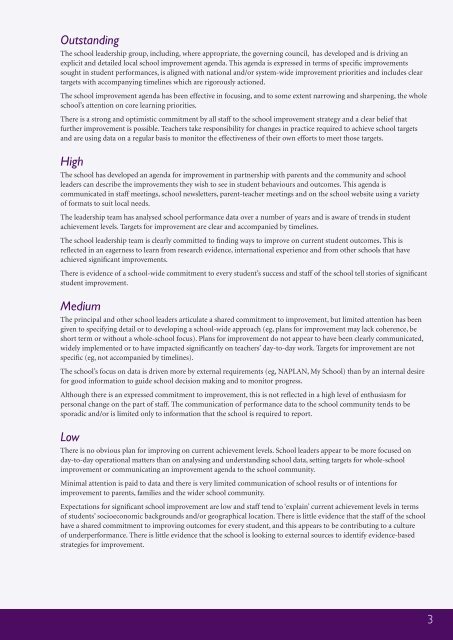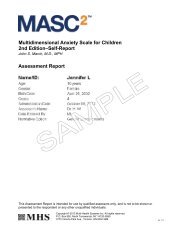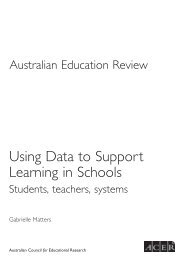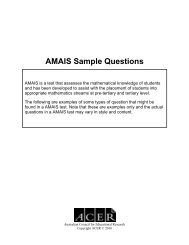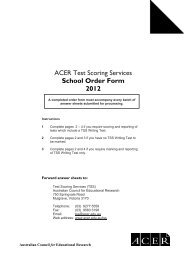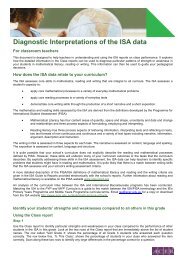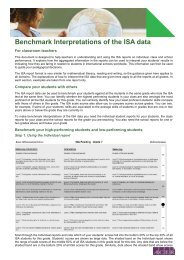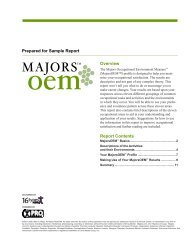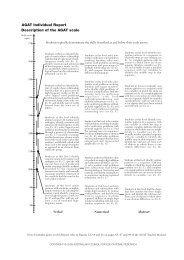National School Improvement Tool - ACER
National School Improvement Tool - ACER
National School Improvement Tool - ACER
Create successful ePaper yourself
Turn your PDF publications into a flip-book with our unique Google optimized e-Paper software.
Outstanding<br />
The school leadership group, including, where appropriate, the governing council, has developed and is driving an<br />
explicit and detailed local school improvement agenda. This agenda is expressed in terms of specific improvements<br />
sought in student performances, is aligned with national and/or system-wide improvement priorities and includes clear<br />
targets with accompanying timelines which are rigorously actioned.<br />
The school improvement agenda has been effective in focusing, and to some extent narrowing and sharpening, the whole<br />
school’s attention on core learning priorities.<br />
There is a strong and optimistic commitment by all staff to the school improvement strategy and a clear belief that<br />
further improvement is possible. Teachers take responsibility for changes in practice required to achieve school targets<br />
and are using data on a regular basis to monitor the effectiveness of their own efforts to meet those targets.<br />
High<br />
The school has developed an agenda for improvement in partnership with parents and the community and school<br />
leaders can describe the improvements they wish to see in student behaviours and outcomes. This agenda is<br />
communicated in staff meetings, school newsletters, parent-teacher meetings and on the school website using a variety<br />
of formats to suit local needs.<br />
The leadership team has analysed school performance data over a number of years and is aware of trends in student<br />
achievement levels. Targets for improvement are clear and accompanied by timelines.<br />
The school leadership team is clearly committed to finding ways to improve on current student outcomes. This is<br />
reflected in an eagerness to learn from research evidence, international experience and from other schools that have<br />
achieved significant improvements.<br />
There is evidence of a school-wide commitment to every student’s success and staff of the school tell stories of significant<br />
student improvement.<br />
Medium<br />
The principal and other school leaders articulate a shared commitment to improvement, but limited attention has been<br />
given to specifying detail or to developing a school-wide approach (eg, plans for improvement may lack coherence, be<br />
short term or without a whole-school focus). Plans for improvement do not appear to have been clearly communicated,<br />
widely implemented or to have impacted significantly on teachers’ day-to-day work. Targets for improvement are not<br />
specific (eg, not accompanied by timelines).<br />
The school’s focus on data is driven more by external requirements (eg, NAPLAN, My <strong>School</strong>) than by an internal desire<br />
for good information to guide school decision making and to monitor progress.<br />
Although there is an expressed commitment to improvement, this is not reflected in a high level of enthusiasm for<br />
personal change on the part of staff. The communication of performance data to the school community tends to be<br />
sporadic and/or is limited only to information that the school is required to report.<br />
Low<br />
There is no obvious plan for improving on current achievement levels. <strong>School</strong> leaders appear to be more focused on<br />
day-to-day operational matters than on analysing and understanding school data, setting targets for whole-school<br />
improvement or communicating an improvement agenda to the school community.<br />
Minimal attention is paid to data and there is very limited communication of school results or of intentions for<br />
improvement to parents, families and the wider school community.<br />
Expectations for significant school improvement are low and staff tend to ‘explain’ current achievement levels in terms<br />
of students’ socioeconomic backgrounds and/or geographical location. There is little evidence that the staff of the school<br />
have a shared commitment to improving outcomes for every student, and this appears to be contributing to a culture<br />
of underperformance. There is little evidence that the school is looking to external sources to identify evidence-based<br />
strategies for improvement.<br />
3


